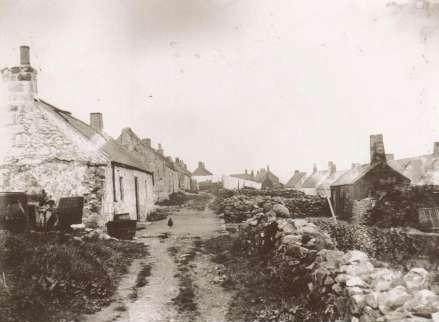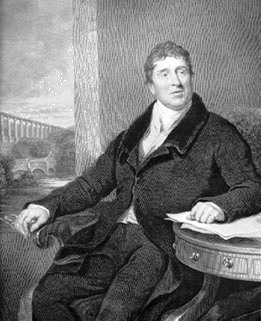
Thomas Telford - an Introduction |
Here is a short introduction to Thomas Telford for those of you not familiar with this famous Scottish Civil Engineer.
 Thomas
Telford was born at Westerkirk in Eskdale, Dumfriesshire, on the 9th of
August 1757. In 1780 he made his way to Edinburgh, where he was employed
in the erection of houses in the new town, and occupied much of his
spare time learning architectural drawing. Moving to London two years
later, he found employment in the erection of Somerset House. Having in
1784 superintended the erection of a house for the commissioner at
Portsmouth dockyard, he next repaired the castle of Sir William Pulteney,
member for Shrewsbury, who conceived such a high opinion of his talents
that he had him made surveyor of public works for the county of Salop.
Thomas
Telford was born at Westerkirk in Eskdale, Dumfriesshire, on the 9th of
August 1757. In 1780 he made his way to Edinburgh, where he was employed
in the erection of houses in the new town, and occupied much of his
spare time learning architectural drawing. Moving to London two years
later, he found employment in the erection of Somerset House. Having in
1784 superintended the erection of a house for the commissioner at
Portsmouth dockyard, he next repaired the castle of Sir William Pulteney,
member for Shrewsbury, who conceived such a high opinion of his talents
that he had him made surveyor of public works for the county of Salop.
In 1793 he was appointed engineer of the Ellesmere canal, for which he built the Chirk and Pont-y-Cysyllte aqueducts, and this work established his reputation as a canal engineer. He was consulted in 1806 by the King of Sweden regarding the construction of the Göta Canal, and, with his plans being adopted; he visited the country in 1810 to supervise some of the more important excavations.
In the early years of the 19th century the question of improving communications in the Highlands of Scotland resulted in Telford being commissioned to report on the matter. In consequence of his recommendations, he was appointed engineer for the Caledonian Canal, which was begun in 1804 and formed one of the largest of his undertakings, and also for the construction of 920 miles of roads, a great part through very difficult country. Subsequently he was employed on the improvement of the road between Carlisle and Glasgow, which was undertaken as a result of a parliamentary inquiry in 1814. Thereafter he was entrusted with the development of a system of roads through the more inaccessible parts of Wales, which involved the erection of the magnificent suspension bridge across the Menai Straits, begun in 1820, and the Conway Bridge, begun in 1822.
While his fame rests chiefly on his road and canal engineering, and the erection of the numerous bridges and aqueducts which this involved, he also worked on harbour construction and the fisheries and industries of Scotland benefited by the improvements he effected at many of the harbours on the east coast.
Telford was never married. For twenty-one years he lived at the Salopian coffee-house, afterwards the Ship Hotel, Charing Cross, from where he finally moved to 24 Abingdon Street. He was a fellow of the Royal Societies of London and of Edinburgh, and was annually elected president of the Institution of Civil Engineers from its foundation. He received the Swedish order of knighthood of Gustavus Vasa.
He died on the 2nd of September 1834 in London, and is buried in Westminster Abbey.
So, where does such a distinguished fellow as Thomas Telford fit in with Portlethen and its modest harbour? See next section - Telford & Portlethen.